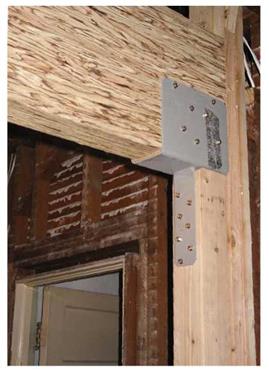ENGINEERED BEAMS
The most daunting part of using engineered beams may be the wide selection. Fortunately, lumberyard staff can usually explain the merits of each type and help you determine correct size.
Glulams, or glue-laminated timbers, are the granddaddy of engineered beams. They’ve been used in Europe since the early 1900s. In North America, they’re fabricated from relatively short pieces of dimension lumber (often Douglas fir or southern pine), which is overlapped or finger – jointed, glued, and pressure clamped. Glulams come in stock widths 3% in. to 6% in., but you can obtain them in almost any size or shape, including curves and arches, as well as pressure treated.
Glulams are expensive, but their stability and strength make them suitable for high loads in clear spans as great as 60 ft. Obviously, you’d need a crane to move such a behemoth.
LVL (Microllam®) is fashioned from thin layers of wood veneer glued together—much like plywood, except the wood grain in all LVL layers runs parallel. It’s stronger than sawn lumber or laminated strand lumber of comparable size, though it’s roughly twice the cost of sawn lumber.
LVL is usually milled as planks 114 in. wide, so it’s typically used as rim joists, cantilever joists, or in-floor headers and beams. It’s a good choice for medium-span beams up to 16 ft., and because individual beams are easy to handle, a small crew can join LVL planks on site to create a built-up girder. LVL is available in other widths, from ЗУ2 in. to 512 in. Depths range up to 20 in.
► Disadvantages: LVL can’t be pressure treated and shouldn’t be used on exteriors. If it gets wet, it will cup. For this reason, keep it covered till you’re ready to use it.
PSL (parallel strand lumber, Parallam®) is created from wood fiber strands 2 ft. to 8 ft. long, running parallel, and glued together under tremendous pressure. PSL is the strongest and most expensive of any structural composite lumber.
Standard PSL sizes are 7 in. to 11 in. wide, up to 20 in. deep, and they can be fabricated to virtually any length—66 ft. is not uncommon. Because they’re stronger than glulams, PSLs are
|
This engineered beam is a 4-in. by 14-in. Parallam girder secured with a Simpson™ CCQ column cap. |
built without camber (a curve built-in to anticipate deflection under load), so they’re easier to align during installation.
PSL beams can be pressure treated and thus can be used outside.
LSL (laminated strand lumber, Timberstrand®) is fabricated from 12-in. wood strands from fastgrowing (but weaker) trees, like aspen and poplar, and then glued together in a random manner. Consequently, LSL carries less load than the beams noted previously, and it costs less.
Still, it is stronger than sawn lumber, though more expensive.
LSL is available in 114-in. to 312-in. widths and in depths up to 18 in., but it’s most often used as short lengths in undemanding locations, such as door or window headers, wall plates, studs, and rim joists.
LSL headers are stable, so they’ll probably reduce nail pops and drywall cracks around doors or windows. But for small openings of 10 ft. or less and average loads, sawn-lumber headers are usually more cost-effective.







Leave a reply